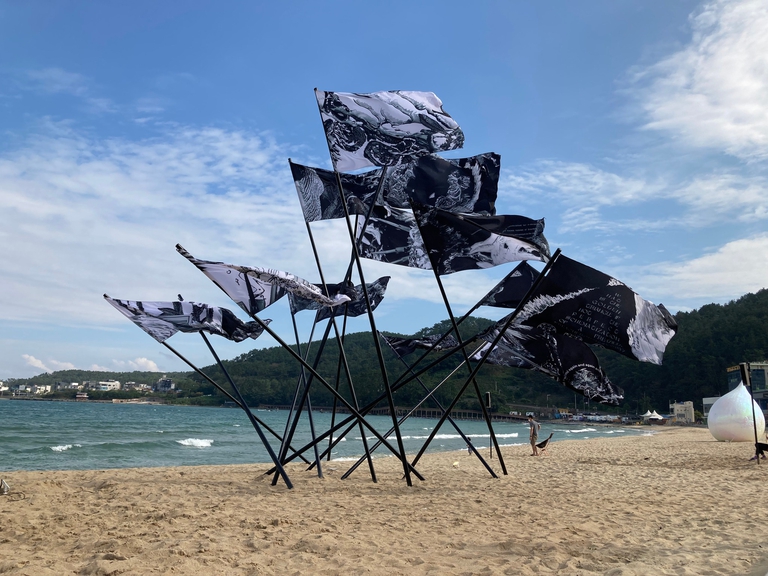Kunsthal Charlottenborg


This event has passed
Public lecture: Forest Curriculum, How To Not Build A Nation
City
Copenhagen, Denmark
Type
Art, Talk
Select your preferred map service
Date
Friday 10th of December 2021
Time
16:00 to 18:00
Price
Free
Fredag d. 10 december kl. 16-18
Kunsthal Charlottenborg biograf
Gratis efter betalt entré
Eventet er på engelsk
Forest Curriculum vil fortælle om deres research og kollektive kunstpraksis omkring projektet "How To Not Build A Nation" (Hvorledes Ikke at Bygge en Nation). How to Not Build a Nation er baseret på en forståelse af de måder, hvorpå nationalstater (både som konceptuelle konfigurationer og empiriske realiteter) reproducerer og foreviger kolonial og prækolonial vold, og på hvilken rolle ikke-menneskelige instanser spiller i disse historiske og nutidige processer.
Projektet er funderet i Zomia-terrænet, højlandet af skove, der forbinder det østlige Sydasien, det sydlige Kina og fastlandet og dele af det archipelagiske Sydøstasien, som har været et territorie for oprindelige samfund, flygtninge, guerillagrupper, ånder, og som for nyligt er blevet voldeligt gennemboret af transnationale infrastrukturprojekter. Projektet minder os om de mange måder, hvorpå nationalstater bevæbner ideer om national enhed for løbende at forarme dem, der er på kanten, ofte gennem brutale militære besættelser.
___________________________________________________________________________
Friday 10 Dec at 16-18
Free after regular admission
The event is in English
Forest Curriculum will talk about their research stream and collective art practice on “How To Not Build A Nation”. How to Not Build a Nation is based on an understanding of the modes in which nation-states (as both conceptual configurations and empirical realities) reproduce and perpetuate colonial and pre-colonial violences, and on the role of non-human agencies through these historical and contemporary processes.
The project grounds itself in the terrain of Zomia, as conceptualised by Wilhelm van Schendel and James C. Scott, the upland swathe of forests that connect Eastern South Asia, Southern China and mainland and parts of archipelagic Southeast Asia, and that has been the territory of indigenous communities, fugitive and guerrilla groups, and spirits, and more recently violently pierced by transnational infrastructure projects. The project reminds us of the many ways in which nation states weaponize ideas of national unity to continuously impoverish those at the margins, often through brutal military occupations.
These other and often dismissed forms of agencies are displayed on the flags draw on figures such weretigers and manananggals, as well opium, and plant species, and symbols of resistance, allowing us other ways to think through and from these territories.weretigers and manananggals, as well opium, and plant species, and symbols of resistance, allowing us other ways to think through and from these territories.weretigers and manananggals, as well opium, and plant species, and symbols of resistance, allowing us other ways to think through and from these territories.
Biography: The Forest Curriculum (Bangkok/Yogyakarta/Manila/Seoul/Berlin/Santa Barbara) is an itinerant and nomadic platform for indisciplinary research and mutual co-learning, based in Southeast Asia, and operating internationally. Founded and co-directed by curators Abhijan Toto and Pujita Guha, and with Rosalia Namsai Engchuan, it works with artists, collectives, researchers, indigenous organizations and thinkers, musicians, and activists, to assemble a located critique of the Anthropocene via the naturecultures of Zomia, the forested belt that connects South and Southeast Asia. The Forest Curriculum organizes exhibitions, public programs, performances, video and multimedia projects, as well as an annual intensive in a different location around the region, which gathers practitioners from all over the world to engage in collective research and shared methodologies: The Forest And The School, Bangkok (2019); The Forest Is In The City Is In The Forest I, Manila (2020) and II, Online (2020-2021). The platform collaborates with institutions and organizations internationally, including Savvy Contemporary, Berlin; Ideas City, the New Museum, NTU CCA, Singapore, Nomina Nuda, Los Baños, and GAMeC, Bergamo among others. The collective has also exhibited in Nonhuman Assemblages, Busan Sea Art Festival, South Korea (2021), and Nation, Narration, Narcosis, Nationalgalerie - Hamburger Bahnhof, Germany (2021).